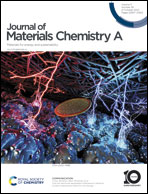Photothermal therapy for cancer cells using optically tunable Fe2O3@Au hexagonal nanodisks†
Abstract
Plasmonic nanostructures have attracted extensive attention for killing cancer cells in photothermal therapy due to their significant absorption activities and photothermal conversion capabilities. However, the development of anisotropic plasmonic nanostructures with tunable near-infrared (NIR) absorptions remains a great challenge. In this study, Fe2O3@Au hexagonal nanodisks (NDs) are prepared by a space-confined growth approach. By choosing uniform and size-tunable Fe2O3 nanodisks as the initial templates, the localized surface plasmon resonance (LSPR) peaks of Au NDs are accurately tuned in the NIR therapeutic window. In addition, by improving the effective photothermal absorption, a high photothermal conversion effect that can exceed 70 °C with 808 nm laser irradiation (2 W cm−2) for 7 min is achieved by 120 nm Fe2O3@Au NDs. We further demonstrate that these Fe2O3@Au NDs simultaneously have both low cytotoxicity and high photothermal therapy (PTT) performance of 89% cancer cell inactivation rate, and can be employed as photothermal therapeutic agents for effective photothermal therapy for cancer cells. This study will provide new insights into a wide range of applications for designing anisotropic plasmonic structures with LSPR enhancement activities.



 Please wait while we load your content...
Please wait while we load your content...